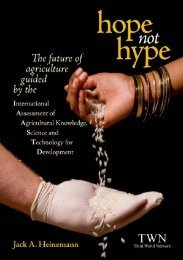gene Flow: Implications for Crop Diversity and Wild Relatives
gene Flow: Implications for Crop Diversity and Wild Relatives
gene Flow: Implications for Crop Diversity and Wild Relatives
- No tags were found...
You also want an ePaper? Increase the reach of your titles
YUMPU automatically turns print PDFs into web optimized ePapers that Google loves.
Identifying the most important components to survival is notstraight<strong>for</strong>ward, <strong>and</strong> must be considered within the ecologyof transgenic hybrids. Variation in fitness is also likely acrosshybrid <strong>gene</strong>rations. With such little knowledge on the behaviourof trans<strong>gene</strong>s in unintended <strong>and</strong> new genomic <strong>and</strong> ecologicalbackgrounds, prediction of real-world effects is particularlychallenging.One principal concern of trans<strong>gene</strong> flow is the loss of potentiallyuseful crop <strong>gene</strong>tic diversity in the recipient population(whether other crops, l<strong>and</strong>races or wild relatives). Outbreedingdepression (the reduction of fitness from hybridisation) can leadto a decrease in allelic diversity by extinction of members of adiverse <strong>gene</strong> pool that are less adapted to survive because of theparticular introgressed transgenic trait. This is loss of diversitythrough negative selection. On the other h<strong>and</strong>, when trans<strong>gene</strong>hybrids have an increased fitness, <strong>and</strong> can survive into the next<strong>gene</strong>ration, <strong>gene</strong>tic assimilation (loss of unique <strong>gene</strong>tic identitythrough continual hybridisation <strong>and</strong> backcrossing) will have ahomogenising effect on the recipient population, also leading toa less diverse <strong>gene</strong> pool. Thus, both instances can have negativeeffects on <strong>gene</strong>tic diversity. The magnitude of these selective<strong>for</strong>ces within the new genomic <strong>and</strong> ecological backgroundof the recipient population will largely determine the rate ofevolutionary change in the recipient population (Gepts & Papa2003).So how can we predict the outcomes of trans<strong>gene</strong> flows ona recipient population? Population matrix models have beensuggested as useful ways to estimate this risk (Parker & Kareiva1996; Bullock 1999). However, the magnitude <strong>and</strong> evidence ofeffects is idiosyncratic, <strong>and</strong> may take years to develop (Ellstr<strong>and</strong>& Hoffman 1990). Few direct studies have been conducted tomeasure the fitness effects of trans<strong>gene</strong>s in wild populations(Linder 1998; Linder et al. 1998; Snow et al. 2001; Spencer &9
















